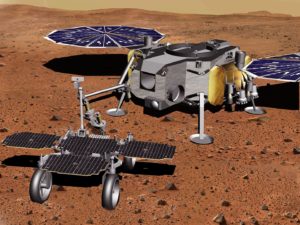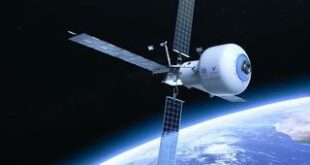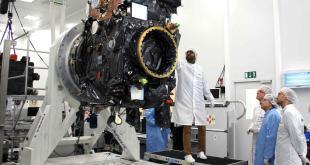
Airbus Defence and Space has won the next phase of the study contract (Advanced B2) from the European Space Agency (ESA) for the advanced Sample Fetch Rover which will be used to collect samples from the surface of Mars.
Mars Sample Return is a joint NASA and ESA campaign to return samples from the Red Planet. NASA’s 2020 Mars rover mission Perseverance will collect Martian soils and rock samples and leave them on the surface in small metal tubes. In 2026 NASA will launch an ESA rover to Mars to collect these tubes. Landing in 2028, the rover will then travel an average of 200 metres a day, over a period of six months to find and pick up the samples. It will collect up to 36 tubes, carry them back to the lander and place them in a Mars Ascent Vehicle which will launch them into orbit around Mars. Another spacecraft developed byESA (with a Nasa payload), the Earth Return Orbiter (ERO), will collect the samples from Martian orbit and return them to Earth.
Airbus in Stevenage is leading the Sample Fetch Rover project, following the completion of the ESA ExoMars rover which is now due to launch in the summer of 2022. The initial phase A and subsequent B1 studies for the Sample Fetch Rover have been underway at Airbus in Stevenage since July 2018. Sophisticated algorithms for spotting the sample tubes on the Martian surface have already been developed by the industrial team led by Airbus, and a dedicated robotic arm with a grasping unit to pick up the tubes is being designed with a pool of European industries.
The accommodation on the NASA lander and the MSR surface mission profile impose new requirements to the SFR locomotion system, which will be equipped with four wheels, larger than the six flexible wheels used on the ExoMars Rover. Type, size and number of wheels has been chosen to better cope with the selected landing site terrain and with the speed and performance required to reach the depot location and return the samples in due time to the lander.
Unlike the ExoMars rover Rosalind Franklin, which has six wheels, the Sample Fetch Rover will only havefour wheels. This is in order to save mass and complexity – but it also presents challenges as the rover has to move more quickly than ExoMars and yet not get stuck on its journey across the surface. TheSample Fetch Rover is required to travel more than 15km across the Red Planet searching and collect up to 36 of the 43 sample tubes left by the Perseverance rover. The samples are due to land back on Earth in 2031.
The latest approval for the Mars Sample Return campaign was given by ESA at its Ministerial meeting in November 2019.
This announcement was made on 16 June 2020 on Airbus.com.





